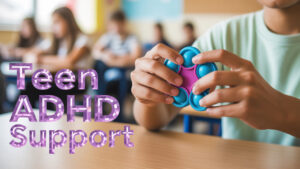Teen Emotional Growth
Teen emotional growth is a key part of adolescent development. This period involves significant changes in brain structure, behavior, and emotional regulation. Understanding this growth helps caregivers and professionals support healthy behaviors and emotional well-being in teens.
Understanding Teen Emotional Growth
Definition and Overview
Teen emotional growth refers to the process of learning how to manage emotional behavior and emotional responses. Emotional development shapes how adolescents understand, express, and process both positive and negative emotions throughout this critical period.
Importance of Emotional Growth in Adolescence
Emotional growth during adolescence lays the foundation for healthy relationships, emotional intelligence, and social skills. It supports the ability to regulate affective experience, manage stressful life events, and avoid risky behaviors. Strong emotional regulation helps teens handle intense emotions and reduces symptoms of depression.
Developmental Stages of Emotional Growth
Early Adolescence (Ages 11–12)
In early adolescence, also referred to as late childhood, teens begin transitioning from childhood through adolescence. The adolescent brain starts to undergo rapid neurobiological development. Hormonal shifts, pubertal development, and asynchronous development across different systems often cause a rollercoaster of emotions. Emotional volatility may increase, leading to unpredictable emotional responses.
Middle Adolescence (Ages 13–16)
Mid-adolescence is marked by heightened emotions and complex emotions. This developmental period includes identity exploration and the formation of peer relationships and romantic relationships. The adolescent brain continues to develop in cortical regions involved in emotional processing, social interactions, and decision-making. Emotional challenges often become more visible as cognitive regulation struggles to keep pace with behavioral development.
Late Adolescence (Ages 17–21)
By late adolescence, cognitive control processes and emotional regulation skills show greater maturity. This extended period marks the shift from concrete thinking to more abstract thinking. Teens begin to reflect on their emotional experiences and form a clearer sense of self, including sexual identity and future goals. Social skills, adaptive response strategies, and emotional intelligence become more refined.
Influences on Teen Emotional Development

Hormonal and Neurobiological Changes
Adolescent brain development includes major changes to the reward centers and affective regions. These biological processes influence emotional behavior, stress response, and reactions to cash rewards or peer approval. Neurobiological development during adolescence impacts how teens manage emotional experiences and respond to emotional stimuli.
Identity Exploration and Adolescence
The development of adolescents includes identity formation, which is influenced by emotional growth, psychosocial development, and social comparison. Sexual identity and personal values emerge, often shaped by emotional challenges and social input.
Role of Social Interactions and Peer Influence
Peer relationships, including friendships and romantic experiences, are central to adolescent behavior. Social interactions shape emotional development by influencing emotional regulation and self-esteem. Safe spaces that support healthy connections help reduce negative affect and promote positive trait formation.
Impact of Societal Expectations
Adolescents face stress from academic pressure, social norms, and digital media. Societal expectations can heighten stress response and affect both emotional development and physical health. Emotional issues may arise when expectations conflict with a teen’s individual developmental trajectory.
Key Challenges in Teen Emotional Growth
Heightened Sensitivity and Emotional Reactions
The teenage brain often reacts strongly to emotional triggers, leading to emotional volatility. Development during adolescence involves learning to manage intense emotions and developing emotional behavior that aligns with long-term goals.
Developing Emotional Regulation Skills
Learning how to pause, breathe, and respond calmly is part of emotional regulation. Strategies like deep breathing and identifying facial expressions help teens manage their affective experience and reduce negative emotions.
Navigating Social Dynamics
Teens face challenges in building and maintaining supportive relationships. Navigating rejection, conflict, and exclusion requires emotional intelligence and cognitive processing. Without support, teens may withdraw or develop emotional issues tied to self-worth.
Role of Parents and Caring Adults

Effective Communication Strategies
Using active listening helps teens feel understood. Consistent support and open dialogue promote emotional well-being and strengthen parent-teen bonds.
Modeling Healthy Behavior
Adults influence adolescent behavior through their own emotional responses. Modeling calm reactions and positive emotional behavior teaches teens how to handle stressful life events and maintain emotional control.
Creating a Supportive Environment
A supportive environment provides structure, stability, and emotional safety. Safe spaces encourage teens to express themselves and explore creative outlets like art, writing, or music.
Providing Guidance and Understanding
Understanding the developmental challenges teens face helps caregivers guide emotional growth with empathy. Providing validation and patience supports the emotional development of adolescent children from childhood to adulthood.
Tailored Strategies for Supporting Emotional Growth
Strategies for Younger Adolescents
Help younger teens identify emotions and develop simple coping strategies. Encourage journaling or drawing as a creative outlet to express feelings.
Approaches for Middle Adolescents
Teens in middle adolescence benefit from direct teaching on emotional regulation and social problem-solving. Practice deep breaths during stress and promote group activities that build social skills.
Interventions for Older Teens
Support older adolescents with tools for emotional processing, abstract thinking, and future planning. Promote cognitive regulation and access to mental health resources when needed.
Special Considerations and Interventions

Recognizing Signs of Emotional Distress
Look for signs like withdrawal, major depression symptoms, or mood swings. Emotional issues may show up as changes in behavior, academic performance, or physical health.
Providing Access to Professional Support
Mental health support is essential for teens struggling with emotional challenges. Therapy can help teens build emotional regulation skills and manage negative emotions.
Encouraging Positive Peer Relationships
Help teens build healthy, respectful peer relationships. Encouraging supportive relationships promotes emotional growth and reduces the impact of stressful life events.
FAQ's
Emotional development during adolescence helps teens build emotional regulation, social skills, and self-awareness. It supports healthy relationships, reduces risky behaviors, and strengthens mental health. This developmental period shapes how teens handle stress, make decisions, and interact with others through childhood to adulthood.
Signs of emotional challenges may include mood swings, intense emotions, emotional volatility, withdrawal from peer relationships, or symptoms of depression. Teens may also show changes in sleep, appetite, or behavior. These signs often reflect underlying stress, emotional issues, or developmental challenges.
Peer relationships play a major role in adolescent development. Positive interactions support emotional growth, social skills, and emotional intelligence. Negative experiences—such as rejection, bullying, or peer pressure—can trigger emotional distress and affect self-esteem or emotional regulation.
Parents can support emotional growth by modeling healthy behavior, creating safe spaces, and using active listening. Providing emotional support, understanding developmental trends, and helping teens build coping tools—like deep breathing and creative outlets—can improve emotional well-being and resilience.









